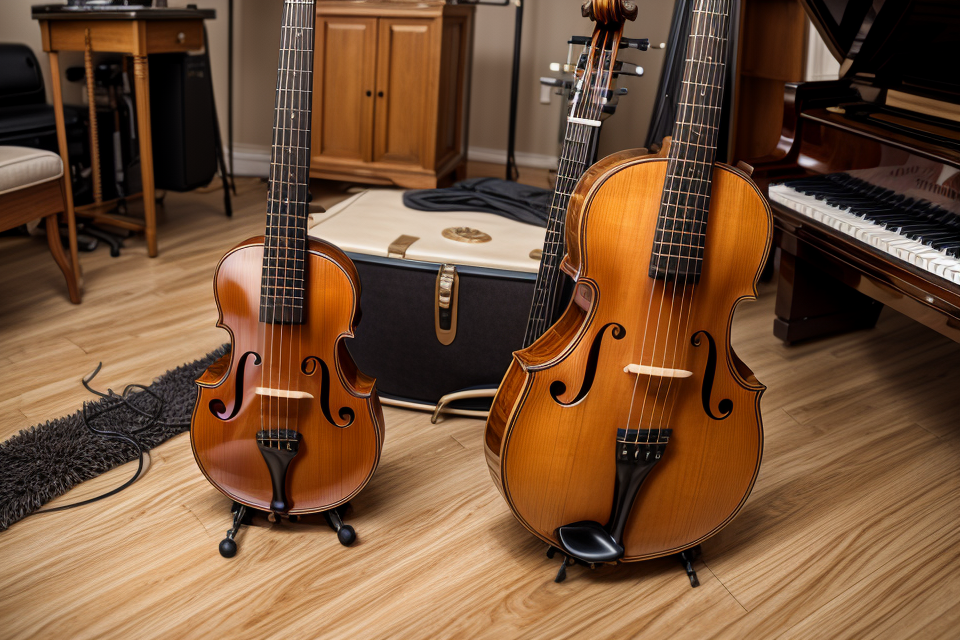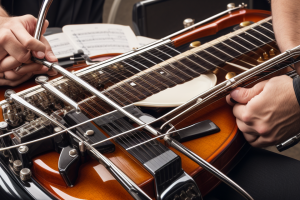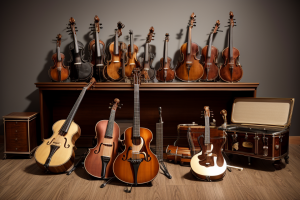
As a musician, you know that your instrument is your trusted companion on your musical journey. It’s essential to take good care of it to ensure that it’s always in top condition. One of the most important aspects of instrument maintenance is cleaning. But how often should you clean your instrument? In this comprehensive guide, we’ll explore the answer to that question and provide you with tips on how to keep your instrument in the best possible shape. So, let’s get started!
Understanding the Importance of Instrument Maintenance
Why Instrument Maintenance is Crucial
- Proper maintenance is crucial for the longevity and functionality of your instrument.
- Regular cleaning and tuning can prevent damage and ensure that your instrument remains in good condition.
- Failure to maintain your instrument can result in costly repairs or even replacement, which can be avoided with proper care.
- Maintenance is especially important for stringed instruments such as violins, cellos, and guitars, which have delicate components that require regular attention.
- In addition to extending the life of your instrument, regular maintenance can also improve its sound quality and performance.
- A well-maintained instrument will have a better tone, be easier to play, and be less prone to malfunctions or breakdowns.
- Regular maintenance can also help to prevent issues such as rusting, cracking, or warping, which can permanently damage your instrument if left untreated.
- In summary, instrument maintenance is crucial for ensuring that your instrument remains in good condition, sounds its best, and lasts for many years to come.
The Risks of Neglecting Instrument Maintenance
Instrument maintenance is a crucial aspect of playing any musical instrument. Neglecting regular maintenance can lead to various risks and potential damage to the instrument. In this section, we will discuss the risks of neglecting instrument maintenance.
Rust and Corrosion
One of the most significant risks of neglecting instrument maintenance is rust and corrosion. Instruments that are made of metal, such as brass and woodwind instruments, are particularly susceptible to rust and corrosion. When these instruments are not cleaned and maintained regularly, they can develop rust and corrosion, which can affect their sound quality and playability. Rust and corrosion can also cause permanent damage to the instrument, making it more difficult and expensive to repair.
Dirt and Debris
Dirt and debris can accumulate on instruments over time, particularly in the crevices and small spaces where they can hide. When left uncleaned, this dirt and debris can attract dust and other particles, which can further damage the instrument. It can also affect the sound quality and playability of the instrument, making it more difficult to play.
Cracking and Damage
Neglecting instrument maintenance can also lead to cracking and damage to the instrument. Instruments that are subjected to extreme temperatures and humidity levels can become brittle and crack. This can happen when the instrument is exposed to very cold or very hot temperatures, or when the humidity level is too high or too low. Cracking and damage can also occur when the instrument is subjected to physical damage, such as being dropped or banged against other objects.
Reduced Lifespan
Finally, neglecting instrument maintenance can also reduce the lifespan of the instrument. Instruments that are not properly maintained can wear out more quickly, and may need to be repaired or replaced more frequently. This can be expensive and inconvenient, and can also affect the sound quality and playability of the instrument.
In conclusion, neglecting instrument maintenance can lead to various risks and potential damage to the instrument. Regular cleaning and maintenance are essential to ensure that the instrument remains in good condition and continues to perform at its best.
Frequency of Instrument Cleaning
Factors that Affect Instrument Cleaning Frequency
- Type of Instrument: The type of instrument can play a significant role in determining how often it needs to be cleaned. For example, woodwind instruments, such as the flute or clarinet, tend to accumulate more moisture and debris due to their design, and therefore require more frequent cleaning. On the other hand, brass instruments, such as the trumpet or trombone, tend to have more complex mechanisms that can benefit from more frequent cleaning and maintenance.
- Playing Habits: The frequency at which an instrument is played can also impact how often it needs to be cleaned. Instruments that are played frequently may require more frequent cleaning to prevent the buildup of moisture and debris. On the other hand, instruments that are played less frequently may not require as much maintenance.
- Environmental Factors: The environment in which an instrument is stored and played can also impact how often it needs to be cleaned. For example, instruments that are stored in areas with high humidity or exposure to dust, dirt, or other particles may require more frequent cleaning to prevent damage to the instrument.
- Maintenance History: The history of maintenance and cleaning for an instrument can also impact how often it needs to be cleaned. Instruments that have been well-maintained and cleaned may not require as much maintenance, while instruments that have not been properly maintained may require more frequent cleaning to prevent damage.
- Personal Preference: Finally, personal preference can also play a role in determining how often an instrument needs to be cleaned. Some musicians may prefer to clean their instruments more frequently for aesthetic or personal reasons, while others may be more relaxed about the frequency of cleaning.
It is important to note that while these factors can impact how often an instrument needs to be cleaned, there is no one-size-fits-all approach to instrument maintenance. Each instrument is unique, and the frequency of cleaning may vary depending on a variety of factors. Therefore, it is important to consult with a professional instrument repair or maintenance specialist to determine the appropriate cleaning frequency for your specific instrument.
Recommended Cleaning Schedule for Different Instruments
The frequency of cleaning your instrument can vary depending on the type of instrument you have. Different instruments have different requirements when it comes to maintenance, and neglecting to clean them properly can lead to damage and even irreparable harm. Here is a recommended cleaning schedule for some common instruments:
Pianos
Pianos are relatively low maintenance, but they still require regular tuning and cleaning. It’s recommended to have your piano tuned at least twice a year, and to have it cleaned by a professional once a year. The inside of the piano, including the keys, strings, and soundboard, should be cleaned and inspected for any signs of damage.
Woodwinds
Woodwind instruments, such as clarinets and saxophones, require more frequent cleaning than pianos. It’s recommended to clean your woodwind instrument after every use, using a soft cloth or swab to remove any moisture or debris. You should also have your instrument professionally cleaned and maintained at least once a year.
Brass
Brass instruments, such as trumpets and trombones, require more extensive cleaning than woodwinds. It’s recommended to clean your brass instrument at least once a week, using a combination of cloths, swabs, and cleaning solutions. The valves and slides should be oiled regularly to prevent sticking, and the instrument should be professionally cleaned and maintained at least once a year.
Strings
String instruments, such as violins and cellos, require daily cleaning to maintain their condition. You should use a soft cloth to wipe down the instrument after each use, paying particular attention to the strings and f-holes. The instrument should also be professionally cleaned and maintained at least once a year, including adjustments to the pegs, strings, and bridge.
Percussion
Percussion instruments, such as drums and cymbals, require minimal cleaning, but it’s still important to keep them in good condition. You should wipe down the instrument with a soft cloth after each use, paying particular attention to the cymbals and drumheads. The instrument should also be professionally cleaned and maintained at least once a year, including adjustments to the hardware and tightening of the drumheads.
In general, it’s important to follow the manufacturer’s recommendations for your specific instrument, as well as to consult with a professional if you’re unsure about how to maintain it properly. Regular cleaning and maintenance can help extend the life of your instrument and ensure that it continues to provide you with many years of enjoyment.
Instrument Cleaning Techniques
Basic Instrument Cleaning Techniques
Proper instrument maintenance is crucial for ensuring the longevity and functionality of your equipment. Regular cleaning is a vital aspect of instrument maintenance, and it is important to understand the basic techniques for keeping your instrument clean. Here are some tips for basic instrument cleaning:
Dusting and Wiping
The first step in cleaning your instrument is to remove any loose debris, such as dust or dirt, that may have accumulated on the surface. Use a soft, dry cloth or brush to gently dust the instrument. Avoid using your fingers or any abrasive materials, as these can scratch the surface of the instrument.
Removing Dirt and Grime
If your instrument has been exposed to more significant amounts of dirt or grime, you may need to use a slightly more aggressive cleaning method. One effective method is to use a soft, damp cloth to wipe down the instrument. Be sure to use a clean, soft cloth that is free of lint or other debris. You can also use a mild soap or cleaning solution, but be sure to rinse the instrument thoroughly with water and dry it completely before using it.
Cleaning Small Crevices
Some instruments have small crevices or hard-to-reach areas that may require more detailed cleaning. For example, the f-holes on a violin or the pegbox on a cello can be difficult to clean thoroughly. In these cases, you may need to use a soft brush or cloth to reach the areas and gently remove any dirt or debris. Be sure to avoid using any abrasive materials, as these can damage the instrument.
Storing Your Instrument
After cleaning your instrument, it is important to properly store it to prevent further damage or dirt buildup. Consider investing in a case or cover to protect your instrument from dust and other environmental factors. Additionally, be sure to adjust the instrument to the proper tuning and secure any loose parts before storing it.
In summary, regular cleaning is an essential aspect of instrument maintenance. By using gentle techniques such as dusting, wiping, and cleaning small crevices, you can help to ensure that your instrument remains in good condition and continues to function properly.
Advanced Instrument Cleaning Techniques
Advanced instrument cleaning techniques involve the use of specialized equipment and cleaning solutions to thoroughly clean and disinfect the instrument. These techniques are recommended for instruments that are used in a clinical setting or for instruments that require a higher level of sterilization.
Autoclaving
Autoclaving is a process that uses high-pressure steam to sterilize instruments. This process is highly effective at killing bacteria, viruses, and other pathogens. Autoclaving should only be performed by trained professionals and the instrument must be properly packaged and prepared for the process.
Ultrasonic Cleaning
Ultrasonic cleaning uses high-frequency sound waves to agitate a cleaning solution and remove debris from the instrument. This technique is particularly effective for cleaning instruments with complex geometries or narrow spaces.
Chemical Sterilization
Chemical sterilization involves the use of chemicals to sterilize the instrument. This process is effective at killing bacteria, viruses, and other pathogens. Chemical sterilization should only be performed by trained professionals and the instrument must be properly prepared for the process.
Dry Heat Sterilization
Dry heat sterilization uses heat to sterilize the instrument. This process is effective at killing bacteria, viruses, and other pathogens. Dry heat sterilization should only be performed by trained professionals and the instrument must be properly prepared for the process.
Plasma Sterilization
Plasma sterilization uses a plasma arc to sterilize the instrument. This process is highly effective at killing bacteria, viruses, and other pathogens. Plasma sterilization should only be performed by trained professionals and the instrument must be properly prepared for the process.
It is important to note that advanced instrument cleaning techniques should only be performed by trained professionals and the instruments must be properly prepared for the process. The choice of technique will depend on the specific instrument and the level of sterilization required.
Tips for Effective Instrument Maintenance
Proper Storage of Instruments
When it comes to instrument maintenance, proper storage is crucial. The way you store your instrument can have a significant impact on its overall condition and lifespan. Here are some tips for proper storage of instruments:
- Choose the right case: The case you choose for your instrument should be durable, protective, and suitable for your instrument’s size and shape. Hard cases are generally better for protecting against impacts, while soft cases are better for portability and storing instruments that are more susceptible to damage from hard surfaces.
- Keep it clean: Before storing your instrument, make sure it is clean and free of any debris or dust. This will help prevent damage to the instrument and ensure it stays in good condition.
- Adjust the strings: If you’re storing your instrument for an extended period, it’s a good idea to loosen the strings slightly to prevent them from getting tangled or stretched. This will also help prevent damage to the neck and body of the instrument.
- Keep it in a stable environment: Extreme temperatures and humidity levels can cause damage to your instrument. Aim to store your instrument in a stable environment with a temperature between 15°C and 25°C and a relative humidity of around 40-50%.
- Check for damage: Before storing your instrument, inspect it for any damage or wear and tear. If you notice any issues, make sure to address them before storing the instrument to prevent further damage.
By following these tips, you can help ensure that your instrument stays in good condition and is ready to play whenever you are.
Using Accessories to Protect Instruments
When it comes to protecting your instrument, there are several accessories that you can use to ensure its longevity and performance. Here are some examples:
- Hard Case: A hard case is a must-have accessory for any instrument. It provides the best protection against impacts, bumps, and other external factors that can damage your instrument. Hard cases are designed to fit specific instruments, so it’s important to choose one that is the right size and shape for your instrument.
- Gig Bag: A gig bag is a more lightweight and portable option than a hard case. It’s ideal for musicians who are on the go and need to transport their instrument to gigs or rehearsals. Gig bags are usually made of nylon or a similar material and have thick padding to protect the instrument from scratches and minor impacts.
- Strap: A strap is an essential accessory for any instrument that you need to carry around. It allows you to wear your instrument like a backpack, making it easier to move around and play. A good strap should be comfortable, adjustable, and made of high-quality materials that won’t damage your instrument.
- Pickup/Microphone: If you play an electric instrument or sing, a pickup or microphone is a must-have accessory. A pickup allows you to amplify your instrument’s sound, while a microphone is essential for vocal performances. These accessories can make a big difference in the quality of your sound and should be chosen based on your specific needs.
- Cleaning Supplies: Finally, it’s important to have a range of cleaning supplies on hand to keep your instrument in top condition. This includes things like cloths, sprays, and wipes that are specifically designed for your instrument. Having these supplies readily available will make it easier to keep your instrument clean and well-maintained.
Regular Check-ups and Repairs
Maintaining your instrument requires more than just cleaning it regularly. It also involves scheduling regular check-ups and repairs to ensure that it remains in top condition. Here are some tips for effective instrument maintenance:
Identify Potential Issues Early On
Regular check-ups can help you identify potential issues before they become serious problems. For example, if you notice that your instrument is out of tune or producing unusual sounds, it may be a sign that something is wrong. By addressing these issues early on, you can prevent further damage and keep your instrument in good condition.
Schedule Regular Repairs
Even with regular maintenance, your instrument may still require repairs from time to time. For example, the strings may need to be replaced, or the pads may need to be regulated. By scheduling regular repairs, you can ensure that your instrument remains in good working order and continues to produce the best possible sound.
Keep Records of Maintenance and Repairs
Keeping records of your instrument’s maintenance and repairs is essential for ensuring that it remains in top condition. This includes keeping track of when the instrument was last cleaned, tuned, or repaired. By keeping detailed records, you can also identify patterns or issues that may arise over time, allowing you to address them before they become serious problems.
By following these tips for effective instrument maintenance, you can ensure that your instrument remains in good condition and continues to produce the best possible sound. Remember, regular check-ups and repairs are essential for maintaining the integrity and longevity of your instrument.
Common Issues with Instrument Maintenance
Identifying and Addressing Common Issues
When it comes to instrument maintenance, identifying and addressing common issues is crucial to ensure optimal performance and longevity of your instrument. Neglecting routine maintenance can lead to damage, poor sound quality, and even irreparable damage to your instrument. In this section, we will discuss some of the most common issues that arise with instrument maintenance and provide practical solutions to address them.
- Dust and dirt buildup: One of the most common issues that affect the performance of wind and string instruments is dust and dirt buildup. Over time, dust, skin cells, and other debris accumulate on the instrument’s surface, particularly in the crevices and hard-to-reach areas. This buildup can affect the instrument’s sound quality, intonation, and overall performance. To address this issue, regular cleaning and maintenance are essential. This includes wiping down the instrument with a soft, dry cloth after each use and using specialized cleaning tools for hard-to-reach areas.
- Sticky keys: Sticky keys are a common issue that affects the playability of keyboard instruments such as pianos and synthesizers. This issue is often caused by dirt, dust, and debris that accumulate under the keys, causing them to stick and making it difficult to play. To address this issue, regular cleaning and maintenance are necessary. This includes regularly cleaning the keys and keybed, using a vacuum cleaner with a soft brush attachment to remove dust and debris from under the keys, and lubricating the key mechanism as needed.
- Rust and corrosion: Rust and corrosion are common issues that affect brass and woodwind instruments, particularly those made of metal. These issues are often caused by exposure to humidity, sweat, and other environmental factors. Rust and corrosion can affect the instrument’s sound quality, playability, and overall performance. To address this issue, regular cleaning and maintenance are essential. This includes wiping down the instrument with a soft, dry cloth after each use, using specialized cleaning tools to remove rust and corrosion from metal parts, and oiling moving parts to prevent rust and corrosion from developing.
- Sticking or slipping pegs: Sticking or slipping pegs are common issues that affect the tuning stability of string instruments. This issue is often caused by dust, dirt, and debris that accumulate on the pegs, making them stick or slip. To address this issue, regular cleaning and maintenance are necessary. This includes wiping down the pegs with a soft, dry cloth after each use, using a peg compound to lubricate the pegs, and adjusting the pegs as needed to ensure proper tuning stability.
By identifying and addressing these common issues with instrument maintenance, you can ensure optimal performance and longevity of your instrument. Regular cleaning and maintenance are essential to prevent damage, poor sound quality, and irreparable damage to your instrument.
Preventing Future Issues
Proper instrument maintenance is crucial in preventing future issues from arising. Here are some steps you can take to ensure your instrument stays in good condition:
- Regular cleaning: As mentioned earlier, cleaning your instrument after each use is essential. Dirt, dust, and debris can accumulate on the instrument’s surface, leading to buzzing or rattling noises, poor tuning, and damage to the instrument’s finish. Use a soft, dry cloth to wipe down the instrument, and avoid using harsh chemicals or cleaners.
- Lubrication: Regular lubrication of the instrument’s moving parts can help prevent buzzing or rattling noises. Use a lubricant specifically designed for musical instruments, and apply it sparingly to the instrument’s moving parts.
- Proper storage: When not in use, store your instrument in a cool, dry place, away from direct sunlight and sources of moisture. This will help prevent damage to the instrument’s finish and internal components.
- Humidification: Some instruments, such as wooden flutes and clarinets, require humidification to prevent cracks from forming due to changes in temperature and humidity. Use a humidifier specifically designed for musical instruments, and maintain the appropriate humidity level according to the manufacturer’s instructions.
- Regular check-ups: Schedule regular check-ups with a professional instrument technician to ensure your instrument is in good condition. A technician can identify any potential issues before they become serious problems, and make any necessary repairs or adjustments.
By following these steps, you can help prevent future issues with your instrument and ensure it stays in good condition for years to come.
Recap of Key Points
- Insufficient cleaning: Not cleaning the instrument regularly can lead to the buildup of dirt, dust, and debris, which can result in damage to the instrument and affect its performance.
- Improper cleaning techniques: Using the wrong cleaning methods or materials can cause damage to the instrument, including scratches, dents, and corrosion.
- Neglecting maintenance: Regular maintenance is crucial for ensuring the optimal performance of the instrument. Neglecting maintenance can result in the instrument becoming out of tune, developing mechanical issues, and eventually becoming unusable.
- Inadequate storage: Improper storage can cause damage to the instrument, such as warping, cracking, or developing mold.
- Lack of knowledge: Many musicians are unaware of the proper cleaning and maintenance procedures for their instruments, which can result in damage and reduced performance.
It is important to address these common issues in order to ensure that your instrument is well-maintained and continues to perform at its best.
Final Thoughts on Instrument Maintenance
Proper instrument maintenance is crucial for ensuring the longevity and performance of your instrument. Neglecting regular cleaning and maintenance can lead to various issues such as rusting, corrosion, and buzzing.
Here are some final thoughts on instrument maintenance:
- It is essential to create a regular maintenance routine to keep your instrument in good condition.
- Cleaning and maintaining your instrument can help prevent costly repairs in the future.
- Consulting with a professional luthier or technician can provide valuable insight into the specific needs of your instrument.
- Always follow the manufacturer’s recommendations for maintenance and cleaning.
- Keep your instrument in a safe and protected case when not in use.
Remember, taking care of your instrument is an investment in its longevity and performance. Regular cleaning and maintenance can help prevent damage and ensure that your instrument stays in top condition for years to come.
FAQs
1. How often should I clean my instrument?
Your instrument should be cleaned after every use, or at least once a week if you’re not using it daily. This helps to prevent the buildup of dirt, dust, and debris that can affect the sound and performance of your instrument. Cleaning your instrument regularly can also help to extend its lifespan by preventing damage from dirt and grime.
2. What are the best methods for cleaning my instrument?
The best method for cleaning your instrument will depend on the type of instrument you have and the level of maintenance it requires. Some instruments may require a gentle cleaning with a soft cloth and a dusting spray, while others may need more thorough cleaning with specialized cleaning solutions and tools. It’s important to consult your instrument’s manual or manufacturer’s recommendations for specific cleaning instructions.
3. How do I clean the different parts of my instrument?
Cleaning the different parts of your instrument may require different methods and tools. For example, cleaning the strings may require a string cleaner or a damp cloth, while cleaning the fretboard may require a specialized fretboard cleaner. It’s important to carefully inspect each part of your instrument and use the appropriate cleaning methods and tools to ensure that all dirt and debris is removed.
4. Can I use household cleaning products to clean my instrument?
No, you should never use household cleaning products to clean your instrument. Many household cleaning products can damage the finish or coatings on your instrument, or leave residue that can attract dirt and grime. It’s important to use only cleaning products specifically designed for musical instruments, and to follow the manufacturer’s instructions carefully.
5. What are the consequences of not cleaning my instrument regularly?
If you don’t clean your instrument regularly, it can become dirty and discolored, and the sound and performance may be affected. In addition, neglecting regular maintenance can lead to damage to the instrument over time, such as rusting or corrosion. Regular cleaning and maintenance can help to prevent these issues and ensure that your instrument stays in good condition for years to come.



